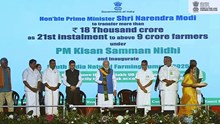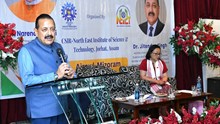
The Union Budget 2023 has given significant relief to the middle classes; however, India’s vast majorities of working people in rural areas and the cities need more focused attention. We may have come out of the COVID-19 pandemic, but the precarity of employment continues. The Periodic Labour Force Survey (PLFS) and other data indicate high levels of unemployment, particularly among youth, continued precarity, and constrained household consumption. Given this, peasants and informal workers of India expected that MGNREGA allocations would at least, if not more, see an allocation of Rs two lakh crores. But, instead, the outlay has been reduced even further to Rs 60,000 crores, which will reduce employment days available, let alone solve the question of payment of pending wages.
With high inflation levels, food support could have significantly relieved most Indian households. However, the allocation to food subsidy has seen a major decrease from Rs 2.87 lakh crore in the revised estimate of 2022-23 to 1.97 lakh crore in this year’s Budget. The withdrawal of the Pradhan Mantri Garib Kalyan Anna Yojana (PMGKAY), and its provision of an extra five kilograms of free food grains to every ration card holder in addition to the entitlement under the National Food Security Act, would put an additional burden on poorer households.
Peasants and informal workers were hoping for dignified social security after the registration under e-Shram However these hopes are denied due to stagnating outlays under the National Social Assistance Programme and Ayushman Bharat and the reduction of allocation for Social Security of Workers from Rs 15,845 crore in the last Budget to Rs 12,434 crore in this budget. India must close the global gap regarding its social protection expenditure as a percentage of its GDP. India spent only 1.4 per cent of its GDP vis-a-vis the global figure of 13 per cent in 2020. Only 24.4% of India’s population is covered by at least one social security scheme (excluding healthcare), and 55% are covered under universal health coverage. In such a situation, a higher allocation of social security was expected.
Investing in agri-tech infrastructure and digitizing PACS are welcome steps that make this budget innovative and creative. Agriculture remains to be the largest employer at 46.5% of the workforce and has increased marginally from 2019-20 to 2020-21. In the view of contracted agricultural growth as per the economic survey, the headwinds the agricultural sector is facing on account of climate change, inflation, and reduction in subsidies, more focus and priority should be given to millions of farming households through the way of greater financial subsidies. Moreover, the question of landless agricultural workers remains with no focus on their protection and welfare.
Expectations were high for assistance under PM Kisan Samman Nidhi to be increased to Rs 8,000 per year; instead, the budget outlays for the scheme have been further reduced. In times of rising extreme weather events and climate change, price support, fertilizer subsidies, and crop insurance act as safety valves for India’s farmers and agricultural workers. However, this budget has reduced allocations to the PM Fasal Bima Yojana, schemes for minimum support price for crop procurement, and the fertilizer subsidies being provided.
We welcome the renewed impetus for the development of Particularly Vulnerable Tribal Groups (PVTGs). Allocation of Rs 15,000 crore for developing basic facilities like safe housing, clean drinking water, and improved access to education and health of PVTGs communities is a welcome step to address the needs and futures of PVTGs. However, what is missed is the longstanding demand for a similar budgetary allocation enhancement for members of semi-nomadic, nomadic, pastoral, and de-notified tribes, comprising 13% of the population, who have historically been at the end of stigmatization, ostracism, and discrimination. The allocation of 40 crores to the Scheme for Economic Empowerment of DNT/NT/SNTs (SEED) is highly insufficient.
The announcement to end the oppressing and inhumane practice of manual scavenging with 100% mechanical desludging of septic tanks and sewers in cities from “manhole to machine-hole” mode is another welcome step. However, the zero allocation to the ‘Self Employment Scheme for Rehabilitation of Manual Scavengers’ is a detrimental step. The Honourable Finance Minister's announcement to support poor prisoners who cannot afford bail amount or penalty is welcome. We hope such support will also be provided to the majority of the undertrials, who are from poor and discriminated communities.
The initiative of green growth and transition to net-zero carbon and several focused proposals are welcome steps. These include the National Green Hydrogen Mission, capital investments towards net-zero, and MISHTI – the Mangrove Initiative and Amrit Dharovar. Under the latter, recognizing local communities as frontline ecological defenders is worth celebrating. Similarly, the initiative to promote millets in the food security program and providing input support through GOBARdhan and PM-PRANAM is a welcome first step. However, the longstanding demand is to expand the public procurement of millet under the National Food Security Act above the current rate of 1%. In that spirit, this could have been incentivized by providing price support to cultivators through the ecological valuation of climate-resilient agriculture.
In this regard, what is missed is the compensation for the impact that frontline communities such as farmers, pastoralists, fish workers, and urban informal workers are facing on climate change. India suffered the second highest loss due to extreme climate events in 2021, racking up nearly $7.6 billion in damages due to flooding and storms, according to the latest report- The State of Climate in Asia 2021, by the World Meteorological Organization and the UN Economic and Social Commission for Asia and the Pacific (ESCAP). Moreover, a World Bank report suggests that by 2030, India may account for 34 million of the projected 80 million global job losses from heat stress-associated productivity decline. In such a situation, budgetary allocation for a national loss and damage financing facility would have been a game changer.
The increased allocations to higher education are a significant investment in India’s future. However, the education expenditure has increased marginally from 2.8% to 2.9% of GDP from 2019 to 2023. The Samagra Shiksha Abhiyan has been provided Rs 37,453 crore, almost identical to last year. On the other hand, PM-POSHAN, which provides nutrition to children in school and anganwadi centres, has seen a reduction in allocation compared to the revised estimates for the ongoing financial year. The latest NFHS-V statistics still mark stunting at 35.5%, wasting at 19.3% and underweight prevalence at 32.1% for children below five years, so expectations for more significant allocations were high. It is also worrying that allotment to education empowerment for minorities has reduced significantly from Rs 2,515 crore in the last budget to Rs 1,689 crore in this one.
The announcement for focusing on eradicating sickle cell anaemia, which plagues the large population of India’s indigenous communities, is a step in the right direction. However, according to the Union Ministry of Health & Family Welfare’s Rural Health Statistics 2021-2022, India’s rural healthcare system continues to be plagued by a shortfall on two critical fronts – doctors and infrastructure. While the increase in health expenditure between 2019 and 2023 from 1.4% to 2.1% of GDP and higher allocation for digital health missions is another forward-looking step, expectations were high for more expenditure on the National Health Mission and health infrastructure development.
In sum, while the Budget has prioritized inclusive development, as the Honourable Finance Minister mentioned in her budget speech, the financial outlay for ensuring it does not show the zeal as hoped. The Finance Minister has announced that Rs. 35,000 crore revenue would be forgone due to a reduction in personal income taxes, and while a relief to the middle classes is welcome, fiscal prudence is not enough to expand public employment, social security, welfare, education, and health expenditures considerably. The need of the hour is to raise revenues through the reduction of revenues forgone and innovative mechanisms such as wealth tax on super accumulation of wealth.













Share your comments